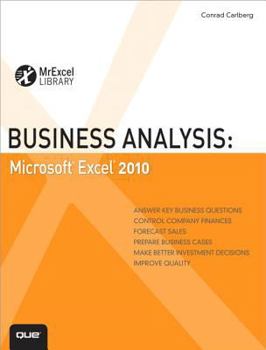Business Analysis: Microsoft Excel 2010
Select Format
Select Condition 
Book Overview
ANSWER KEY BUSINESS QUESTIONS CONTROL COMPANY FINANCES FORECAST SALES PREPARE BUSINESS CASES MAKE BETTER INVESTMENT DECISIONS IMPROVE QUALITY USE EXCEL 2010 TO GAIN DEEPER INSIGHTS, MAKE SMARTER... This description may be from another edition of this product.
Format:Paperback
Language:English
ISBN:0789743175
ISBN13:9780789743176
Release Date:January 2010
Publisher:Que
Length:515 Pages
Weight:1.80 lbs.
Dimensions:1.1" x 7.1" x 9.2"
Customer Reviews
3 ratings
A 'must' for any business or business-oriented computer library
Published by Thriftbooks.com User , 13 years ago
Business Analysis: Microsoft Excel 2010 is a 'must' for any business or business-oriented computer library. It goes beyond the usual Excel basics to show how to use Excel 2010 to gain deeper insights into business. Excel expert Conrad Carlberg shows how to use Excel 2010 to perform core financial tasks from analyzing statements and managing sales to creating and using advanced queries. Very highly recommended!
Do better business with Excel
Published by Thriftbooks.com User , 13 years ago
This book is different from other Excel books I've read. The usual approach is to explain what Excel can do and how to do it. This unusual approach reverses the process, identifying business problem and processes, then showing how Excel can help to do the job. There are four sections: Analyzing Financial Statements, Financial Planning and Control, Investment Decisions and Sales and Marketing. Each section takes a business process, explaining it for those not familiar with it, then showing how Excel can help to eliminate work or illustrate information that might not have been evident. For example, the first section deals with Income Statements, Balance Sheets, Inventories, Cash Flow and Ratios. In each case, the author shows what Excel can do to make your life easier. The book uses Excel 2010 as its basis, but mentions how a process might be different when using an earlier version of Excel. Actually, very little reference is made to the tabs present in both Excel 2007 and 2010. Rather, the method of preparing the object at hand is the focus. The Financial Planning and Control section covers Budgeting and Planning in some depth. The Forecasting chapter explains how the various estimation methods available in Excel differ and the situations in which might be used. The author discusses moving average forecasts, regression and smoothing with Excel's functions. He even covers the concept of Box-Jenkins methods, although the subject is too extensive to cover in this book. Another interesting chapter is Measuring Quality, which delves into the subject of sampling using various statistical methods. Statistics comes up again in the Making Investment Decision Under Uncertain Conditions. Here the author covers using standard deviation, confidence intervals and regression analysis. The book is filled with screen shots of Excel applying the ideas in the text. This gives you a good idea of how to apply the ideas to your own work. The book includes a helpful glossary and a useful index. This is a great book for one in business who is familiar with Excel and wants to use it to improve the company's analysis and operations.
Business Analysis
Published by Thriftbooks.com User , 13 years ago
Business Analysis: Microsoft Excel 2010 covers two broad accounting topics: management accounting and financial accounting. The first part of the book looks primarily at day to day accounting procedures. This includes a well thought out discussion on whether to use Quick Books or other readymade accounting programs or to use Excel to create your own templates. There are pros and cons on both sides of the issue. It is also possible, if done carefully, to use the best of both. Following this discussion, the book moves into how to create various schedules, ledgers, and summaries. For those new to the inner workings of accounting, the book explains some key concepts as well as the purposes behind the various forms and calculations. Various examples are used with instructions on the formulas and layouts. There are also lots of illustrations so that you know you are on the right track. The book transitions to budgeting and planning. This is the part of the process where Excel really shines. It's so very easy to analyze, manipulate, and reorganize the data in a variety of different ways to not only see where your business is right now but also project how it could grow. Really, it's about making good business decisions based on fact and knowledge about the inner workings of your company rather than just tossing a coin in the air and hoping you made the right choices.




